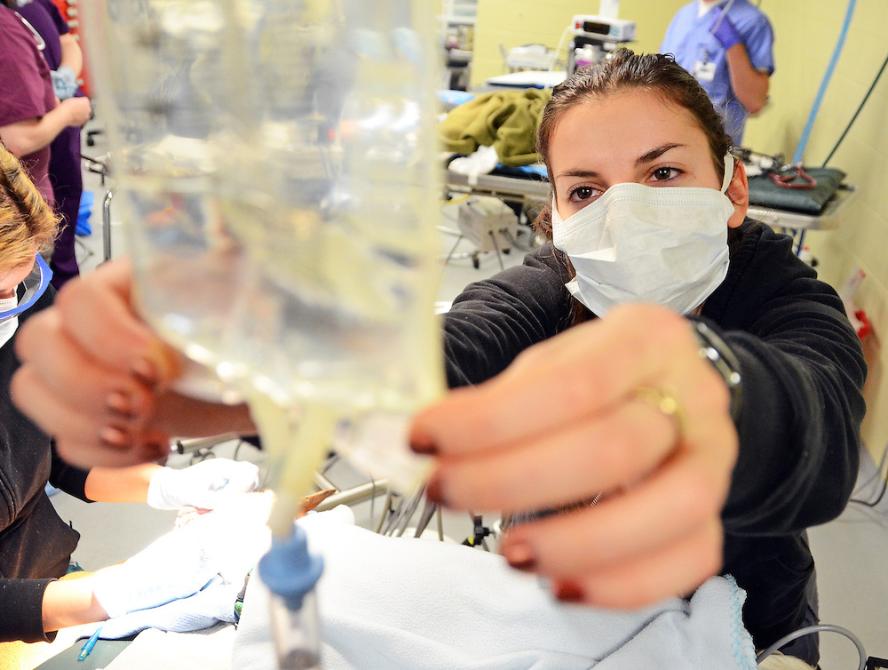-
About
- Leadership & Faculty
- News & Events
-
Admissions
-
Academics
- Graduate
- Advanced Clinical Training
- Continuing Education
-
Student Life
-
-
Accommodations
- Our Campus
-
Accommodations
- Graduate Resources
-
-
Research
-
Hospitals & Clinics
- Emergency Care
- Hospital Services
-
Community Outreach
- Volunteer
Although Microscopic in Size, Antibiotic Resistant Bacteria Pose a Large Threat
Since their discovery, antibiotics have played an important role in keeping both humans and animals healthy, but the emergence of antibiotic resistant bacteria has become a major public health threat. What’s being done, and how can you help?

Touted as one of the greatest discoveries in the 20th century, antibiotics have played an important role in keeping both humans and animals healthy since their discovery. However, the emergence of antibiotic resistant bacteria has become a major public health threat.
What Are Antibiotic Resistant Bacteria?
Antibiotic resistant bacteria are bacteria that are not controlled nor killed by antibiotics. “In some cases, resistance is a natural phenomenon that some bacteria have as part of their genetic makeup,” says board-certified Emergency and Critical Care Specialist at Foster Hospital for Small Animals, Dr. Annie Wayne. “But other resistances are driven by antimicrobial use and emerge due to selection pressure or random mutations in the presence of antibiotics, like Darwin’s survival of the fittest.”
Who Does Antibiotic Resistant Bacteria Affect?
Because antibiotics are used in human and veterinary healthcare, the development of antibiotic resistant bacteria has the potential to have an impact on multiple populations. “It is a major Center for Disease Control (CDC) and World Health Organization (WHO) concern over the next 10, 15, 20 years,” says Dr. Wayne.
Although there is not a significant amount of data on the impact of antibiotic resistance in companion animals as of yet, veterinarians are taking note of changes. “We are seeing dogs and cats with recurrent infections that are resistant,” says Dr. Wayne. “Some bacterial infections that once were very treatable with antibiotics have become resistant to every antibiotic that we have available.”
With evidence that people and their pets can share bacteria between them, there is cause for concern for any member of the household when faced with the possibility of getting an infection that isn’t treatable by an antibiotic.
What is Being Done About Antibiotic Resistant Bacteria?
Dr. Wayne is part of a research collaborative with the Tufts University School of Medicine and is working to implement the same strategies that are being used in human healthcare for veterinary healthcare.
While there are no restrictions on the amount or type of antibiotics that can be used in dogs and cats currently, veterinarians are working toward prescribing the antibiotic that has the narrowest spectrum—meaning it treats only the specific bacteria that is causing the infection—and using it for the shortest course possible. And, for diseases that don’t have evidence of bacterial infections, it is important avoid the use of antibiotics.
By lessening the amount of antibiotics that bacteria are exposed to, two things happen: First, it can prevent some types of resistance from forming; and second, some bacteria will reduce some of those resistance patterns over time. “So, if an animal that has a persistent infection is not exposed to certain antibiotics for months or years, those antibiotics may become useful again,” says Dr. Wayne.
How Can I Help?
Dr. Wayne recommends pet owners have an open line of communication with their veterinarian. If your pet is prescribed an antibiotic, ask your veterinarian if it is necessary and what is the shortest course of treatment your pet likely needs. And, make sure you give the antibiotics as they are prescribed. Just like you practice stewardship with your doctor, it’s important that pet owners and their veterinarians work together toward a resolution.